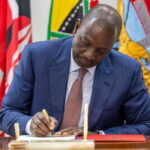Russian President Vladimir Putin has sent warm words to U.S. President Donald Trump just a day before they meet in Alaska to talk about ending the war in Ukraine. The unexpected praise comes as both sides prepare for tense, high-stakes talks that could reshape global politics.
Putin told Russian media that Trump’s efforts to bring peace were “energetic and sincere.” The comments are seen by many as part of a charm offensive ahead of the summit. While the main focus will be Ukraine, Putin has signaled he also wants to discuss trade, arms control, and broader U.S.–Russia relations.
The meeting will be held at Joint Base Elmendorf-Richardson in Anchorage, the closest U.S. state to Russia, just a short distance across the Bering Strait. Kremlin aides say it’s a symbolic location, with Soviet pilots from World War II buried nearby as a reminder of past cooperation between the two nations.
Russian Foreign Minister Sergey Lavrov has already arrived in Alaska and says Moscow will present a “clear and well-defined” position. He declined to predict the outcome, telling Rossiya 24 TV:
📰 Also Read This:
“We know that we have arguments. Our stance is clear. We will present them.”
Lavrov noted that Trump’s special envoy, Steve Witkoff, has visited Russia five times since Trump took office. Their last meeting, just a week ago, lasted three hours and focused heavily on Ukraine.
Moscow has made it clear that any lasting peace in Ukraine must meet several strict conditions. The first is that Ukraine must never join NATO. Russian officials argue that NATO membership would put a hostile military alliance right on Russia’s doorstep, a threat they say could reignite old tensions with the West. From Moscow’s perspective, preventing this is crucial for the country’s security and for maintaining regional stability.
The second condition Moscow insists on is that Ukraine be “demilitarized” and “denazified.” In practical terms, this means significantly reducing Ukraine’s military capabilities and removing groups that Russia claims hold extremist or anti-Russian views. While Ukraine and its allies reject these claims as propaganda, Russian leaders argue that such measures are necessary to avoid future conflicts and to lay the groundwork for lasting peace.
Finally, Russia demands that Ukraine formally recognize Crimea, Donetsk, Lugansk, Kherson, and Zaporozhye as part of the Russian Federation.
The Kremlin points to referendums held in 2014 and 2022 as proof that these regions chose to join Russia, though Kyiv and most of the international community consider the votes illegal. By seeking official recognition, Moscow hopes not only to end the current war but also to secure diplomatic and legal acknowledgment of the borders it has established on the ground.
These regions voted to join Russia in referendums held in 2014 and 2022, votes that Ukraine and the West reject as illegal. Russia also currently controls parts of Kharkov, Sumy, and Dnepropetrovsk regions.
Trump has suggested the idea of a land-swap deal between Russia and Ukraine, but Russia firmly rejects giving up any territory.
Trump has been lashing out at critics ahead of the talks. On Truth Social, he accused the media of quoting “fired losers” like his former national security adviser John Bolton, who said Putin has “already won” simply by being invited to U.S. soil.
“What’s that all about? We are winning on EVERYTHING,” Trump posted, calling such reports “Fake News.”
Bolton, in a recent interview, called the summit a “big win for Putin” and described him as a “pariah leader” being given an undeserved platform.
Speaking from the Oval Office, Trump said the Ukraine conflict “should never have started” and insisted that “everybody” is to blame, including previous U.S. administrations, Ukraine, and Russia itself.
“Everything that we did was wrong. Everybody’s to blame. Putin’s to blame. They’re all to blame,” Trump said.
He emphasized that the war was never discussed during his first four years in office and that he hopes the Alaska talks can at least set the stage for peace.
The Russian delegation will include Lavrov, Defense Minister Andrey Belousov, Finance Minister Anton Siluanov, investment envoy Kirill Dmitriev, and Kremlin aide Yury Ushakov. Experts will also be on hand for technical discussions.
The U.S. delegation has not yet been fully announced, but the White House says it will include top national security and economic officials.
The summit will begin with a private one-on-one meeting between Putin and Trump, each joined only by an interpreter. Larger five-on-five talks will follow.
Both Washington and Moscow are warning against expecting an instant breakthrough. Putin’s spokesman Dmitry Peskov said there will likely be no documents signed. Trump has described it as a “feel-out meeting” to better understand Putin’s position.
Despite this, the very fact that the meeting is happening is being called historic. Relations between the U.S. and Russia had been nearly frozen since 2022 under President Joe Biden, when Washington tried to “isolate” Moscow over the Ukraine war.
Beyond geography, Alaska has deep historical symbolism. During World War II, it was a key transit point for U.S. planes delivered to the Soviet Union under the Lend-Lease program. For both sides, meeting there sends a message: there was once a time when America and Russia fought side by side.
European leaders, particularly in NATO states, have been wary of the Alaska meeting. Moscow accuses them of “militarizing Europe” and preparing for “a real war against Russia,” in Lavrov’s words. Peskov added that Russia does not expect “a sensible response” from European capitals to any peace proposals discussed in Alaska.
Trump has made it clear that he wants the war in Ukraine to end. Putin has made it clear he will not give up territory. Whether there’s a middle ground is the big question, and Alaska could be the first step toward finding it.
As the two leaders prepare to shake hands in Anchorage, the world will be watching closely. The stakes are high, the positions are far apart, and yet both men are signaling they’re ready to talk.







